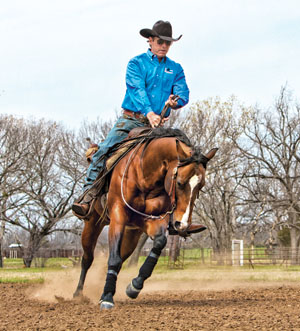I’ve noticed in my clinics that riders often don’t know how to use their hands. They’re afraid of using them incorrectly, so they wind up not using them at all. Once they do know how to use their hands effectively, it’s a major boost to their in-saddle confidence.

This simple exercise, where you use your little finger on your horse’s neck to stabilize the reins, will teach your hands to be quiet yet effective as you encourage your horse to learn how to soften to the bit on his own.
Why it works. Good hands mean still hands. Busy hands confuse and irritate your horse. Classic horsemanship tells us that to get collection and refinement, you must be able to release rein pressure at the exact instant your horse gives a response. Then you take hold again, then release again at the tiniest “try.” I believe it’s my horse’s job to figure out how to get that release himself. Keeping my hand still enables him to do this. It’s similar to when you tie the reins with contact and turn your horse loose in the round pen—your horse teaches himself how to find that sweet spot where contact disappears.
How to do it. Warm your horse up, then put him into a steady trot. Hold your reins as you normally would in your left hand. With your right hand, grasp the reins just below your rein hand, then use your rein (left) hand to draw the reins up, pulley fashion, until you establish a light contact with your horse’s mouth. Then, extend the pinkie finger of your right hand downward until it touches your horse’s neck. Hold the reins firmly in your right hand (so they don’t slide through) and keep that pinkie finger planted. This maintains unchanging contact with your horse’s mouth—no bouncing or bumping. Keep driving your horse forward at a trot and notice when he adjusts his frame to soften his contact with the bit.
Use your legs. Be sure to keep using leg pressure to drive your horse up into your hand. If your horse isn’t responding and giving you that soft feel in your hand, that means his feet aren’t free. When a horse braces his neck, it’s because of resistance in his feet. Cluck and drive him forward with energy to enable him to find that sweet spot.
Keep at it. This exercise is easiest to teach at the trot; once your horse stays soft and light at that gait, try it at a walk, then a lope. At the walk, especially, be sure to maintain a nice forward rhythm with his hind end or he’ll lose impulsion. At the lope, don’t let him convince you that you must turn him loose—remember, it’s up to him to turn loose of you by rounding his topline and softening in the jaw. Once you both get the hang of it, you’ll discover how useful it can be just to take the slack out, put your finger down, and go for a ride.
Craig Johnson, Gainesville, Texas, is a National Reining Horse Association Million Dollar Rider, a two-time NRHA Futurity champion, and a member of the gold-medal-winning 2002 World Equestrian Games U.S. team. He now presents horsemanship clinics around the world (craigjohnsonreining.com).






